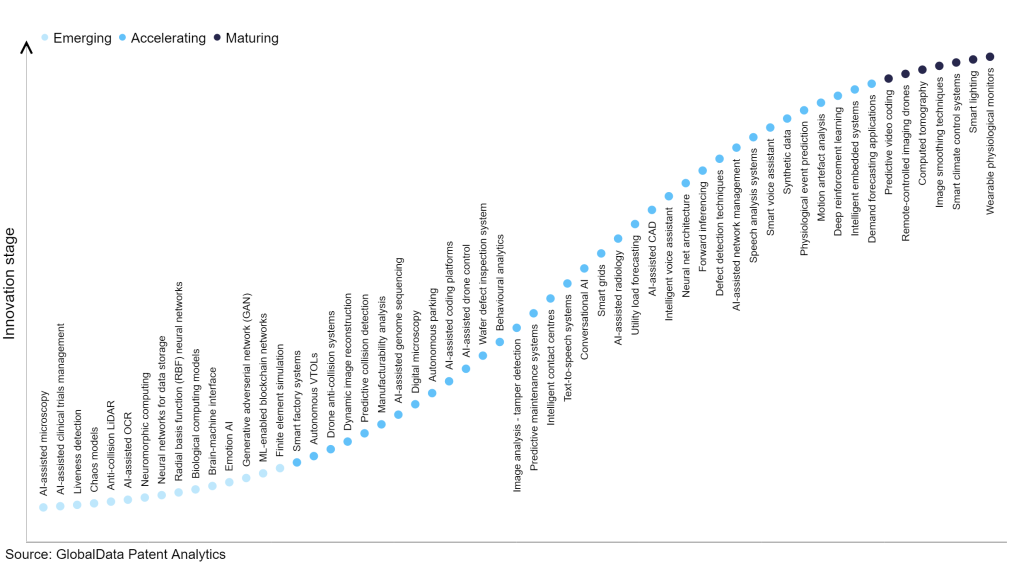The technology industry continues to be a hotbed of innovation, with activity driven by the widespread adoption of artificial intelligence (AI) and virtual assistants in various industries, the increasing demand for voice-controlled smart home devices, as well as advancements in natural language processing and machine learning. This has also resulted in the growing importance of technologies such as automatic speech recognition, natural language understanding, and personalised recommendation systems. These technologies work collectively to enhance the user experience and enable more seamless interactions with other devices. In the last three years alone, there have been over 3.6 million patents filed and granted in the technology industry, according to GlobalData’s report on Innovation in Artificial Intelligence: Smart voice assistant. Buy the report here.
However, not all innovations are equal and nor do they follow a constant upward trend. Instead, their evolution takes the form of an S-shaped curve that reflects their typical lifecycle from early emergence to accelerating adoption, before finally stabilising and reaching maturity.
Identifying where a particular innovation is on this journey, especially those that are in the emerging and accelerating stages, is essential for understanding their current level of adoption and the likely future trajectory and impact they will have.
300+ innovations will shape the technology industry
According to GlobalData’s Technology Foresights, which plots the S-curve for the technology industry using innovation intensity models built on over 2.5 million patents, there are 300+ innovation areas that will shape the future of the industry.
Within the emerging innovation stage, finite element simulation, ML-enabled blockchain networks and generative adversarial network (GAN), are disruptive technologies that are in the early stages of application and should be tracked closely. Demand forecasting applications, intelligent embedded systems, and deep reinforcement learning are some of the accelerating innovation areas, where adoption has been steadily increasing. Among maturing innovation areas are wearable physiological monitors and smart lighting, which are now well established in the industry.
Innovation S-curve for artificial intelligence in the technology industry

Smart voice assistant is a key innovation area in artificial intelligence
Smart voice assistants are software applications that utilise artificial intelligence and natural language processing to comprehend and address voice instructions. They possess the ability to execute diverse tasks such as delivering weather updates, news summaries, playing music, facilitating online shopping, and managing smart home devices.
GlobalData’s analysis also uncovers the companies at the forefront of each innovation area and assesses the potential reach and impact of their patenting activity across different applications and geographies. According to GlobalData, there are 660+ companies, spanning technology vendors, established technology companies, and up-and-coming start-ups engaged in the development and application of smart voice assistant.
Key players in smart voice assistant – a disruptive innovation in the technology industry
‘Application diversity’ measures the number of different applications identified for each relevant patent and broadly splits companies into either ‘niche’ or ‘diversified’ innovators.
‘Geographic reach’ refers to the number of different countries each relevant patent is registered in and reflects the breadth of geographic application intended, ranging from ‘global’ to ‘local’.
Patent volumes related to smart voice assistant
Source: GlobalData Patent Analytics
Alphabet is a leading patent filer in the smart voice assistant space. One of the company’s patents describes methods, devices, and computer-readable media for improving the automated assistant's ability to understand and respond to abrupt transitions between different subjects during a conversation with a user. In this approach, natural language input is received from the user while conversing with the automated assistant. The input is parsed using selected grammars based on topics stored in the ongoing conversation's contextual data structure. The parsed input is used to generate a natural language response, which is then output to the user. Any new topics raised in the input or response are identified and added to the contextual data structure.
Other prominent patent filers in the space include Samsung and Microsoft.
By geographic reach, JK-Holding leads the pack, followed by 1-800 Contacts and iRobot. In terms of application diversity, The Charles Stark Draper Laboratory holds the top position, followed by Rateze Remote and Zhejiang Prism Holographic Technology.
AI innovation in smart voice assistants has significant implications for enhancing user interactions and improving convenience. By leveraging artificial intelligence and natural language processing, smart voice assistants can understand and respond to voice commands, allowing users to perform various tasks effortlessly. This technology enables hands-free operation, provides personalised assistance, and seamlessly integrates with other smart devices and services. Smart voice assistants have the potential to transform daily routines, streamline tasks, and enhance accessibility, making them a valuable tool in improving productivity and enhancing the overall user experience.
To further understand how artificial intelligence is disrupting the technology industry, access GlobalData’s latest thematic research report on Artificial Intelligence (AI) – Thematic Intelligence.
Data Insights
From

The gold standard of business intelligence.
Blending expert knowledge with cutting-edge technology, GlobalData’s unrivalled proprietary data will enable you to decode what’s happening in your market. You can make better informed decisions and gain a future-proof advantage over your competitors.







